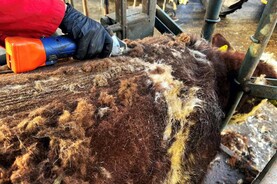Grazing is nearing an end on many livestock farms and over the next month, winter housing will start as grass runs out or ground conditions deteriorate.
Until then, use your time to get sheds ready for winter housing.
Outlined are five jobs to focus on.
1. Wash and disinfect cattle sheds
If sheds have yet to be cleaned out, do so as soon as possible.
A couple of hours every day will soon add up, leaving sheds ready for winter.
Wash sidewalls, side sheets and - provided it is safe to do so - the shed roof.
Turn off power feeds into the shed when washing close to lights and electrical outlets.
Leave sheds to air dry, then disinfect walls and side sheets, concentrating on corners and areas where pathogens are likely to multiply.
2. Replace and upgrade work lights
Replace bulbs that have blown, opting for LED lights to increase visibility. Upgrading to LEDs in general is a good investment.
Completing this task before cattle are housed gives better access to lights above pens. Consider adding an extra light in sheds with poor visibility.
Good lighting is also essential around silage clamps or areas where bales are stored, improving visibility and making these areas safer to work in over winter.
3. Adjust and repair feed gates
If feed barriers and dividing gates are hard to open or in need of repair, this is another job to complete before housing starts. Include any broken kicker boards along the feed passage.
Alter feed rails to suit weanlings, stores or cows. Do not forget about the bull. If there is time, paint the bottom of feed gates in contact with silage to prevent corrosion.
4. Lagging water pipes and fixing water troughs
Lag exposed water piping before housing starts, especially in sheds where drinking water is prone to freezing.
Fix any leaks on water troughs and make sure there is adequate flow for refilling drinkers. Empty out troughs and remove any debris that accumulated over the summer period.
5. Altering airflow
Think back to previous years. Do animals in certain sheds always have problems with pneumonia over winter?
Test the air flow with a smoke bomb or, alternatively, fill a meal bag with straw and light it in cattle pens, keeping a bucket of water close by to extinguish flames.
As the smoke rises, it should exit at the ridge of the shed roof. However, if smoke swirls and congregates above pens, then ventilation needs to be sorted before housing time.
Replace a few side sheets with Yorkshire cladding, which will improve the intake of air, while opening the ridge on the shed roof allows stale air to exit sheds quicker.
Read more
Grass+ Beef: tight grass supplies likely to cause early housing
Watch: blown away by spring barley at harvest
Grazing is nearing an end on many livestock farms and over the next month, winter housing will start as grass runs out or ground conditions deteriorate.
Until then, use your time to get sheds ready for winter housing.
Outlined are five jobs to focus on.
1. Wash and disinfect cattle sheds
If sheds have yet to be cleaned out, do so as soon as possible.
A couple of hours every day will soon add up, leaving sheds ready for winter.
Wash sidewalls, side sheets and - provided it is safe to do so - the shed roof.
Turn off power feeds into the shed when washing close to lights and electrical outlets.
Leave sheds to air dry, then disinfect walls and side sheets, concentrating on corners and areas where pathogens are likely to multiply.
2. Replace and upgrade work lights
Replace bulbs that have blown, opting for LED lights to increase visibility. Upgrading to LEDs in general is a good investment.
Completing this task before cattle are housed gives better access to lights above pens. Consider adding an extra light in sheds with poor visibility.
Good lighting is also essential around silage clamps or areas where bales are stored, improving visibility and making these areas safer to work in over winter.
3. Adjust and repair feed gates
If feed barriers and dividing gates are hard to open or in need of repair, this is another job to complete before housing starts. Include any broken kicker boards along the feed passage.
Alter feed rails to suit weanlings, stores or cows. Do not forget about the bull. If there is time, paint the bottom of feed gates in contact with silage to prevent corrosion.
4. Lagging water pipes and fixing water troughs
Lag exposed water piping before housing starts, especially in sheds where drinking water is prone to freezing.
Fix any leaks on water troughs and make sure there is adequate flow for refilling drinkers. Empty out troughs and remove any debris that accumulated over the summer period.
5. Altering airflow
Think back to previous years. Do animals in certain sheds always have problems with pneumonia over winter?
Test the air flow with a smoke bomb or, alternatively, fill a meal bag with straw and light it in cattle pens, keeping a bucket of water close by to extinguish flames.
As the smoke rises, it should exit at the ridge of the shed roof. However, if smoke swirls and congregates above pens, then ventilation needs to be sorted before housing time.
Replace a few side sheets with Yorkshire cladding, which will improve the intake of air, while opening the ridge on the shed roof allows stale air to exit sheds quicker.
Read more
Grass+ Beef: tight grass supplies likely to cause early housing
Watch: blown away by spring barley at harvest






 This is a subscriber-only article
This is a subscriber-only article









SHARING OPTIONS: